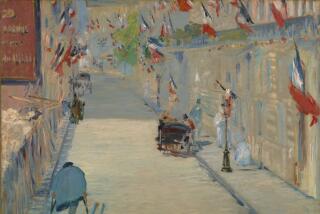‘Hearts of the City’ by Herbert Muschamp
Hearts of the City
The Selected Writings
of Herbert Muschamp
Herbert Muschamp
Alfred A. Knopf: 888 pp., $50
In December 1997, with the Getty Center finally set to open its expansive hilltop campus after more than a decade of frustration, Herbert Muschamp told readers of the New York Times that, at the very least, the museum could “take pride in arousing discontent.” If that read like a backhanded compliment, it shouldn’t have, given the source. “Conflict is the most important cultural product a city puts out,” Muschamp would later write. Certainly, no American critic generated more of it than Muschamp, who spent a dozen imperious years as the Times’ chief architecture critic, beginning in 1992.
Muschamp stepped down in 2004, three years before his death from lung cancer. Whatever one thinks of his writing, there can be no argument that the worlds of both letters and architecture are reduced by his absence. His provocative columns drew a devoted following and endeared him to top brass at his paper, even after much of the world he covered, not to mention his own editors, had tired of him.
All that was beguiling and exasperating about Muschamp is evident in “Hearts of the City: The Selected Writings of Herbert Muschamp,” a tombstone that takes its title from an unfinished manuscript, a kind of architectural memoir, on which the critic was working at the time of his death. It appears, in a few revealing fragments, at the close of the book that now bears its name.
From his very first pieces for the New Republic, Muschamp evinced a keen grasp of architectural history -- he authored a fine book about Frank Lloyd Wright and New York, “Man About Town” -- and a willingness to bridge disciplines and embrace popular culture, especially gay culture. In a typically capricious 1998 essay on the nature of design, he jumped from mythology to physiology to psychology to sociology, combining them with a rumination on the contents of his medicine cabinet. He was prone to giddy flights of self-referential fancy, the most famous, or infamous, being his description of Frank Gehry’s titanium-clad Guggenheim Museum in Bilbao, Spain, as “the reincarnation of Marilyn Monroe.”
If such phrasing suggests a certain fixation on celebrity and glamour, it’s only appropriate, for those were qualities he admired. Muschamp paid occasional lip service to the idea that buildings should be understood as integral parts of an urban fabric and not, in his words, as “discrete objects floating in space,” but he nevertheless tended to treat them as the latter, racking up countless air miles on visits to would-be landmarks designed by a select group of international luminaries. There was no bigger star in Muschamp’s firmament than Gehry, who commands nearly a full column in the index of “Hearts of the City.” Other favorites included Peter Eisenman, Rem Koolhaas, Zaha Hadid, Jean Nouvel and Renzo Piano.
That he wrote about these avant-garde architects with great frequency, and to the apparent exclusion of other, less fashionable voices, was a persistent frustration within the profession. He disdained the contextual architecture of the New Urbanism movement and completely ignored green design; environmental issues barely warrant passing reference in his writing. New Yorkers, especially those in the outer boroughs, often felt they were left entirely off a radar that seemed only to ping for signature buildings by signature designers in far-off locales. It is telling that there are more references to Barcelona than to Brooklyn in “Hearts of the City.”
When Muschamp did write about New York, he was typically damning. He carped that “no serious architecture” had been built in Manhattan in the two decades before his arrival at the New York Times, that the city was controlled by craven developers and that it possessed a “preservation mentality” that stifled creativity. These were debatable assertions and together demonstrated a disinterest in the essential job of architecture to negotiate difficult political forces.
Muschamp’s critical proclivities might have been less controversial had he not wielded such enormous power, and so ruthlessly. His position at the Times made him the most prominent architectural writer in the nation, if not the world, a status he guarded jealously. He was notoriously vindictive. In 2000, when Slate published a three-part exegesis on his influence, no architects were willing to go on record criticizing the critic.
His influence became most apparent in the wake of Sept. 11, when aesthetics should have taken a back seat to rational planning and the city most needed an objective voice at its paper of record. Instead, Muschamp inserted himself into the design process, publishing a “Masters’ Plan” -- note the position of the apostrophe -- for ground zero in the Times magazine. His salve for the site of national catastrophe was “visionary architecture” as realized by a handpicked cast of design luminaries. “Fantasies of new buildings are a form of recovery,” he wrote in an accompanying essay, unforgivably absent from “Hearts of the City.” Such grandiose ideas quickly became an expedient tool for politicians, developers and architects who placed their own interests before the public good.
Muschamp saw no romance in the intricacies of these real-world battles. Instead, he seemed always to be chasing a vague sense of “cosmopolitanism,” which he described as “a state of mind, an emotional aptitude that originates in the subconscious and in the architecture of fantasy of which we can never be fully conscious.” A child of 1950s suburban Philadelphia, he approached New York as if it were a theater of the imagination. In a telling autobiographical passage, he claimed his audience was himself at age 12, or “a small rat stranded somewhere in the suburbs, seeking to lift his or her horizons above the maze of American consumerism.”
In his last years, Muschamp’s writing became increasingly baroque and appeared most often in the Times’ Sunday style magazines, where his obsession with glamour seemed at least thematically appropriate. His final piece was a rumination on the handbags of Queen Elizabeth II.
Perhaps the greatest irony of Muschamp’s writing is that it will become ever more enjoyable over time, as the controversy he valued so highly ebbs, forgotten, into history. Stripped of his bully pulpit, Muschamp is no longer an incendiary figure, and his writing offers only the considerable pleasures of a gifted thinker engaged in his chosen subject, a resource to be valued by those who loved and loathed him.
Lamster is the author of “Master of Shadows,” a political biography of Peter Paul Rubens.
More to Read
The biggest entertainment stories
Get our big stories about Hollywood, film, television, music, arts, culture and more right in your inbox as soon as they publish.
You may occasionally receive promotional content from the Los Angeles Times.










